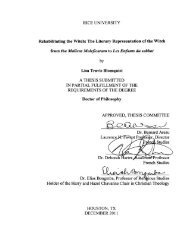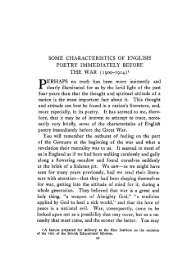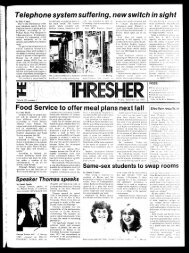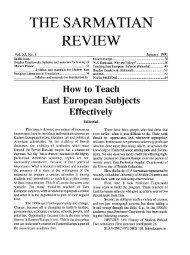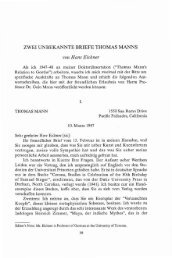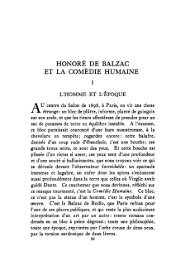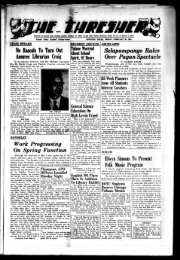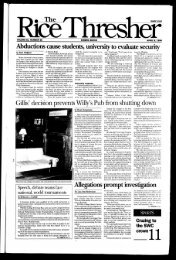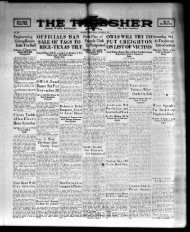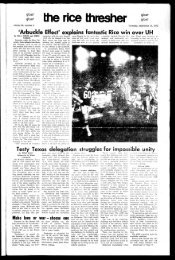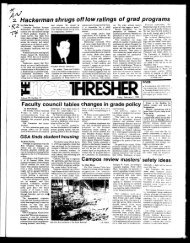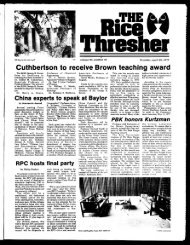The church at Las Condes
The church at Las Condes
The church at Las Condes
Create successful ePaper yourself
Turn your PDF publications into a flip-book with our unique Google optimized e-Paper software.
While directing a Rice University architectural<br />
team working in Chile under a Ford Found<strong>at</strong>ion<br />
grant. School of Architecture Associ<strong>at</strong>e Director<br />
Paul Kennon discovered an unusual monastery<br />
<strong>church</strong>, and described it in a letter to William W.<br />
Caudill, Director of the School.<br />
<strong>The</strong> <strong>church</strong>. Monasterio Benedictino de <strong>Las</strong> <strong>Condes</strong>,<br />
is a powerful and primitive architectural st<strong>at</strong>ement,<br />
modeled with stark white poured-in-place concrete<br />
and rough form boarding. Professor Kennon was<br />
impressed by the unpretentious strength of the<br />
little <strong>church</strong> — and by the masterful harnessing of<br />
n<strong>at</strong>ure to cre<strong>at</strong>e dram<strong>at</strong>ic, ever-changing light p<strong>at</strong>terns<br />
for the interior.<br />
When Professor Kennon discovered th<strong>at</strong> the building<br />
was designed by a pair of monks who live<br />
in the adjoining monastery, he asked them to write<br />
in their own words their concepts for their <strong>church</strong>.<br />
<strong>The</strong> result — commentary by the monks, photographs<br />
by Rice gradu<strong>at</strong>e student Tom Daly, and<br />
Professor Kennon's original letter describing the<br />
building — is "Monasterio Benedictino de <strong>Las</strong><br />
<strong>Condes</strong>," Architecture <strong>at</strong> Rice 20.<br />
— <strong>The</strong> Editor<br />
AUentras dirigía un gru/jo de arquitectos de Rice<br />
en Chile, que trabajaban como becados de la Ford<br />
Found<strong>at</strong>ion, Paul Kennon, Director Associado de la<br />
Escuela de Arquitectura de Rice, descubrió una<br />
extraordinaria iglesia en un monasterio y la describió<br />
en carta a William W . Caudill, Director de<br />
la Escuela.<br />
La iglesia, del Monasterio Benedictino de <strong>Las</strong> <strong>Condes</strong>,<br />
es un sólido y primitivo edificio, moldeado con<br />
hormigón fraguado totalmente blanco y riistico<br />
maderamen.<br />
Al professor Kennon le impresionó la despretenciosa<br />
fuerza de la pequeña iglesia y la magistral habilidad<br />
de la n<strong>at</strong>uraleza en crear dramáticos y siempre<br />
cambiantes efectos de luz en el interior.<br />
Cuando el profesor Kennon descubrió que el edificio<br />
había sido dibujado por un par de monjes que<br />
vivían en el tnonasterio contiguo, les pidió que<br />
describieran con sus propias palabras su concepto de<br />
la iglesita. El resultado—comentario de los monjes,<br />
fotografías de estudiante postgraduado Tom Daly, y<br />
la carta original del profesor Kennon describiendo el<br />
edificio— es "Monasterio Benedictino de <strong>Las</strong> <strong>Condes</strong>"<br />
Architecture <strong>at</strong> Rice 20,<br />
—El Redactor





